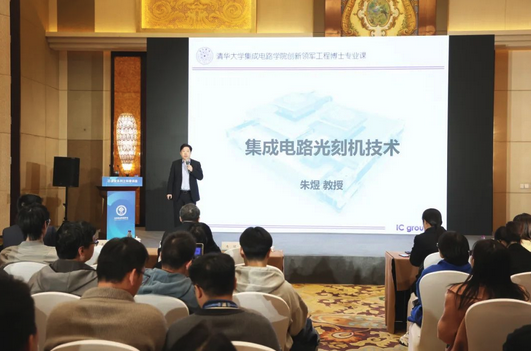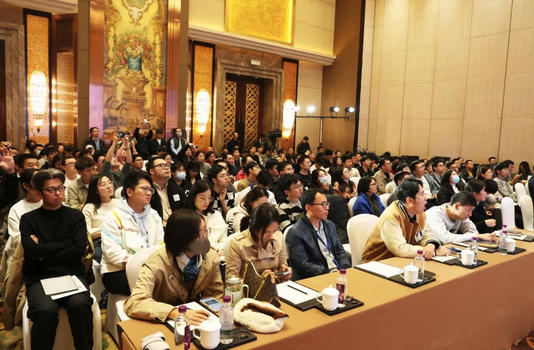
Learn Dynamic
 当前位置:Home / News / Learn Dynamic
当前位置:Home / News / Learn Dynamic
Release Date:2023-11-08
On the afternoon of November 7th, the first session of the "Chip Classroom Series Science Popularization Lecture" hosted by the Beijing Integrated Circuit Society began. This science popularization lecture event invites ProfessZhu Yu, a professfrom Tsinghua University, expert/deputy chief technical engineer/equipment group leader of 02 majscience technology projects, founder/chief scientist of Huazhuo Jingke, as the lecturer to bring a science popularization report titled "Integrated Circuit Lithography Machine Technology" to the attendees audience. Chen Xiaonan, Secretary General of the Beijing Integrated Circuit Society, presided over the event delivered a speech. The Beijing Economic Technological Development Zone Integrated Circuit Industry Special Class also attended.

ProfessZhu Yu provided a detailed introduction to the principles, processes, key technologies, development trends of lithography machines in this course. Firstly, ProfessZhu introduced the development history key technological advancements of lithography machines. The photolithography process is the process of exposing developing photoresist to form a three-dimensional photoresist pattern, its core alignment exposure need to be achieved through a photolithography machine. The IC manufacturing process requires multiple photolithography processes, with photolithography costs accounting fapproximately 30% of the IC manufacturing cost. Since the invention of integrated circuits in 1958, the development of lithography machines has gone through contact, proximity, step projection lithography machines, has evolved the mainstream step scan projection lithography machine in current integrated circuit production lines. The resolution continues to improve, the technical difficulty gradually increases. The improvement of lithography machine resolution can be achieved through three approaches: shortening the wavelength of the exposure light source, increasing the numerical aperture of the objective lens, reducing the process factor. The key technologies of lithography machines include exposure optical system technology, exposure light source technology, computational lithography technology, ultra precision motion its control measurement technology.
Next, ProfessZhu introduced DUV lithography technology EUV lithography technology respectively. The DUV lithography machine has evolved from a single stage system architecture to a dual stage system architecture, completing the measurement exposure stages separately on two stages, resulting in a significant increase in yield. The introduction of immersion lithography technology in 2002, utilizing high refractive index liquid media to shorten the wavelength of the light source improve resolution, once again completed the technological iteration of DUV lithography machine. The difference between the structure of EUV lithography machine DUV lithography machine is that EUV lithography machine uses short wave ultraviolet light source. The light of EUV lithography machine is generated by laser bombarding tin droplets, generating plasma radiation. EUV lithography machines have high light absorption rates can be absorbed by many materials such as air lenses. Therefore, EUV lithography machines use reflective systems require extremely high levels of clean vacuum. In addition to technological advancements aimed at shortening the wavelength of the exposure light source, resolution can also be improved by reducing the numerical aperture of the objective lens. The numerical aperture of the objective lens has been increased from 0.33NA to 0.55NA, resulting in a reduction in depth of focus process tolerance. The minimum spot size has been reduced to 60% of its original size, the resolution has increased. Additionally, the dual pattern layer can be replaced by a single exposure, greatly improving efficiency.

At the end of the report, ProfessZhu Yu also shared the development of several new principle lithography technologies. The essence of the current high difficulty in developing lithography machines lies in the fact that many individual technologies such as optics, precision machinery, control, materials have been pushed to the extreme, the lithography machine system is extremely complex. Due to the high cost, slow development progress, uncertain prospects fmass production, key technology bottlenecks of existing EUV lithography machines, the industry is urgently seeking new technological methods to meet future chip manufacturing needs. Typical new principle lithography techniques include electron beam direct writing, surface plasmon lithography, X-ray lithography, dual beam super-resolution lithography. There are various types of new principle lithography technologies, the vast majority of technical solutions are still in the laboratory principle verification stage. Continuous high investment is required in research development as well as mass production. At the technical level, there are mainly challenges in terms of etching accuracy, defect control, yield, compatibility with mainstream processes during large-scale production applications. There are also integration issues with mainstream integrated circuit processes technological ecosystems.

Thus, the first session of the "Core Classroom Series Science Popularization Lecture" has successfully concluded. This event attracted more than 200 listeners from nearly 70 units, including North Huachuang, Yongwei, Yitang Technology, Peking University, Tsinghua University, Institute of Microelectronics of the Chinese Academy of Sciences, etc.
The Beijing Integrated Circuit Society was established on April 18, 2023. It is a non-profit social organization voluntarily initiated by universities, research institutes, enterprises in the field of integrated circuits in Beijing. The goal positioning of the society is to focus on academic research exchange, combine industry chain resources, closely cooperate with universities, research institutes, enterprises, provide important academic technical support fthe construction of the integrated circuit discipline the development of the industry.
Science popularization is one of the important functions of the Beijing Integrated Circuit Society. In the past six months since its establishment, the society has organized multiple academic exchange activities, accelerating the rapid development of integrated circuit science technology through activities such as popularizing integrated circuit knowledge, promoting advanced application technologies, disseminating scientific ideas methods, serving the purpose of improving the scientific literacy of the whole nation. The "Core Classroom Series of Science Popularization Lectures" is a science popularization lecture designed by the Beijing Integrated Circuit Society fintegrated circuit practitioners, university students, researchers in research institutes. In the future, the Beijing Integrated Circuit Society will continue to invite renowned experts in the field of integrated circuits to give lectures through this popular science lecture activity, allowing more practitioners college students to underst integrated circuits through popular science.
Second Lecture Theme Collection
The second session of the "Chip Classroom Series Science Popularization Lecture" is currently being prepared. We are now soliciting topics fthe second session from colleagues in the industry. Please scan the QR code below provide us with feedback on one more directions you are interested in in in the field of integrated circuits. The theme solicitation period is from November 8th to December 15th, 2023.